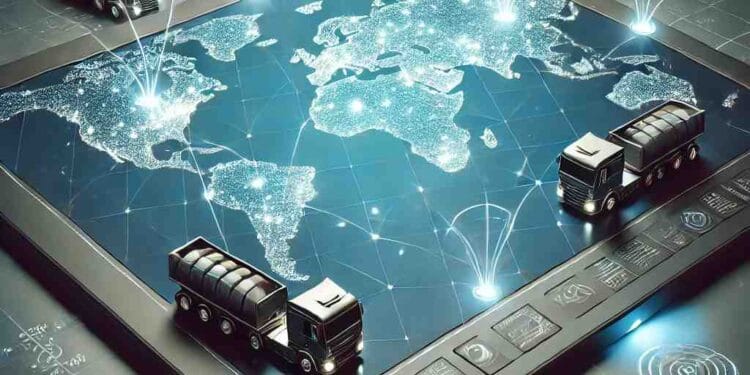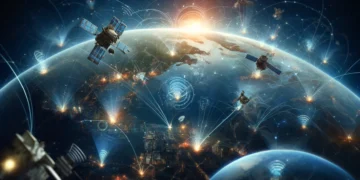Envision a world where all vehicles, assets, teams, and even the most outlying ones remain connected in uninterrupted ways. This vision is gradually becoming a reality through satellite fleet management, an innovative technology revolutionizing how industries and Companies execute their business processes. Therefore, through IoT and satellites, large organizations or companies can fully achieve higher output, reliability, and control, primarily when operating in challenging terrains.
This article explains the principles, uses, and potential of changing satellite fleet management. It covers everything from helping IoT satellite companies to offering robust satellite IoT solutions and, more importantly, how it revolutionizes operational processes across automotive industries, logistics, and beyond.
What Is Satellite Fleet Management: Definition
Satellite Fleet Management can be defined as utilizing satellite networks to monitor, control, and coordinate vehicles, stocks, or equipment fleets. In contrast with typical fleet management solutions that rely on terrestrial communication systems, this approach utilizes satellite communication for entire coverage areas, including the most remote and extreme zones.
Key Components:
- IoT Satellite Communication: Splice sensor and device with a satellite system for real-time data interconnectivity.
- Satellite Network: The platform supports uninterrupted communication between people and companies worldwide.
- Private Satellite Network: Vertically integrated solutions for connecting different industries using highly secure and dedicated pathways.
How Does Satellite Fleet Management Work?
Satellite IoT fleet management is driven by the IoT devices installed in satellites.
Here’s how it operates:
- Connected devices installed on vehicles, equipment, and other assets gather such valuable information as location, performance, temperature, humidity, etc.
- These devices will send data through satellite networks to the management platforms without interference from the regular terrestrial networks.
- The data thus collected will be processed and analyzed, and the results will be available to the fleet managers for decision-making.
- Satellites allow for transmitting and receiving signals, ultimately providing ways of controlling the device from a distance and receiving fresh data.
Applications of this Management
1. Automotive Industry
- Connected Cars: In the present age of self-driving and connected cars, satellite fleet management maintains constant connectivity to address navigation, diagnostics, and safety.
- In-Vehicle NTN Connectivity: For the private vehicle manufacturers involved, non-terrestrial networks (NTN) that allow vehicles to remain connected even in areas away from terrestrial networks are essential.
2. Logistics and Supply Chain
- Tracking: Helps to track goods and vehicles in real-time, even in a different country.
- Route Optimization: Analyse its data to provide information about the shortest routes with the least fuel costs and delivery time.
3. Remote Industries
- Mining and Agriculture: Operate fleets of machinery and mobile vehicles in areas without any Terrestrial network connection.
- Energy Sector: Supervise and regulate equipment in remote oil platforms, pipelines, or wind solar power generation centers.
Advantages of Satellite Fleet Management
1. Unmatched Coverage
Most traditional fleet management systems have issues when operating in remote or Geographically Complex Regions. Satellite networks enable the management of a fleet with international reach from desolate cities and rural landscapes to deserted deserts and seas.
2. Reliability
Terrestrial networks are vulnerable to weather conditions, natural disasters, and uncertainties regarding infrastructure. Nevertheless, satellite technology provides a stable and reliable signal connection independent of conditions.
3. Scalability
A private satellite network is excellent for growing businesses as they can expand their services without being constrained by the available connections.
4. Security
Satellite communication networks can be enhanced with one or several layers of protection to ensure data security.
5. Cost-Effectiveness
Although the implementation of satellite IoT solutions may seem high initially, they are incredibly cost-effective given that their one-time investment in overnight assets’ minimal downtime, correctly identified ideal routes, and overall optimization of operations provide for a return on investment.
Role of IoT in Satellite Fleet Management
Considering the IoT as an enabler for satellite fleet management, different devices, vehicles, and systems are connected seamlessly.
- IoT Satellite Service optimizes real-time data gathering, enhancing fleet managers’ productive decisions.
- IoT Satellite Companies: Promote innovation by uniquely creating superior IoT platforms compatible with satellite usage.
- Satellite IoT Solutions: Offer solutions allowing industries to manage, track, and regulate fleets from one location.
Why Satellite Technology Is Essential
Telecommunications are essential in satellite fleet management by providing the necessary network apparatus.
- Global Reach: Makes it possible that no vehicle or asset is ever left out.
- Interoperability: Last but not least, IoT can be easily incorporated into existing structures, thereby enabling organizational adoption while less disrupting the organizations’ operations.
- Future-Proofing: It is still growing through innovations such as low-earth orbiting LEO satellites, which are next-generation satellite solutions.
Overcoming Challenges
1. Connectivity in Remote Locations
Some industries, such as mining or oil/gas exploration and development, may occur within regions with no recommended terrestrial networks. Satellite fleet management addresses this problem by guaranteeing consistent communication and control.
2. Managing Costs
Although such a network can be costly, the owners can design their network systems to serve their needs best, and there will be little or no waste.
3. Data Latency
Satellite communication has also become faster, often interspersed with several delays. This is tackled using better satellites and algorithms to improve updates and aid real-time decisions.
Satellite Fleet Management for Connected Cars
The car manufacturing industry is on the edge of a significant shift due to the emergence of connected cars and autonomous vehicles.
It plays a crucial role in the following:
- To support alternative navigation and safety system networking without complications.
- Bring updates on the roads and the weather prevailing at any given time or location.
- Some benefits include guaranteeing that vehicles in inaccessible or developing areas continue to have communication access.
Satellite Fleet Management for Remote Industries
Several industries, such as agriculture, energy, and logistics, are in extremely remote areas. For such industries, satellite IoT solutions are simply indispensable.
- Asset Monitoring: Ensure that track usage and equipment performance are monitored to avoid any equipment collapsing midway.
- Workforce Connectivity: Provide convenient ways of communication between various groups of workers to enhance efficiency on the project or at different production lines, which is necessary for the safety of all.
- Environmental Monitoring: Gather information about the climate, ground, and other factors and conditions to help influence the efficiency of the programs.
Final Thoughts
Fleet management for satellites is more than just an evolution of technology; it is a new way of breaking the geographical barrier that has often held businesses back through adequate resourcefulness on the five fundamental principles of operational excellence, security, and the ability to work sustainably.
To address these connectivity issues, remote asset management and operational optimization industries can use IoT satellite communication, reliable satellite networks, and specific satellite IoT solutions.
From improving the functionality of connected cars to offering a lifeline to remote industries, satellite fleet management is shaping a new paradigm for the world and operating at the pinnacle of efficiency.
As the demand for reliable and scalable solutions grows, integrating IoT and satellite technology will continue to drive innovation, ensuring that every fleet, vehicle, or asset is always within reach.












